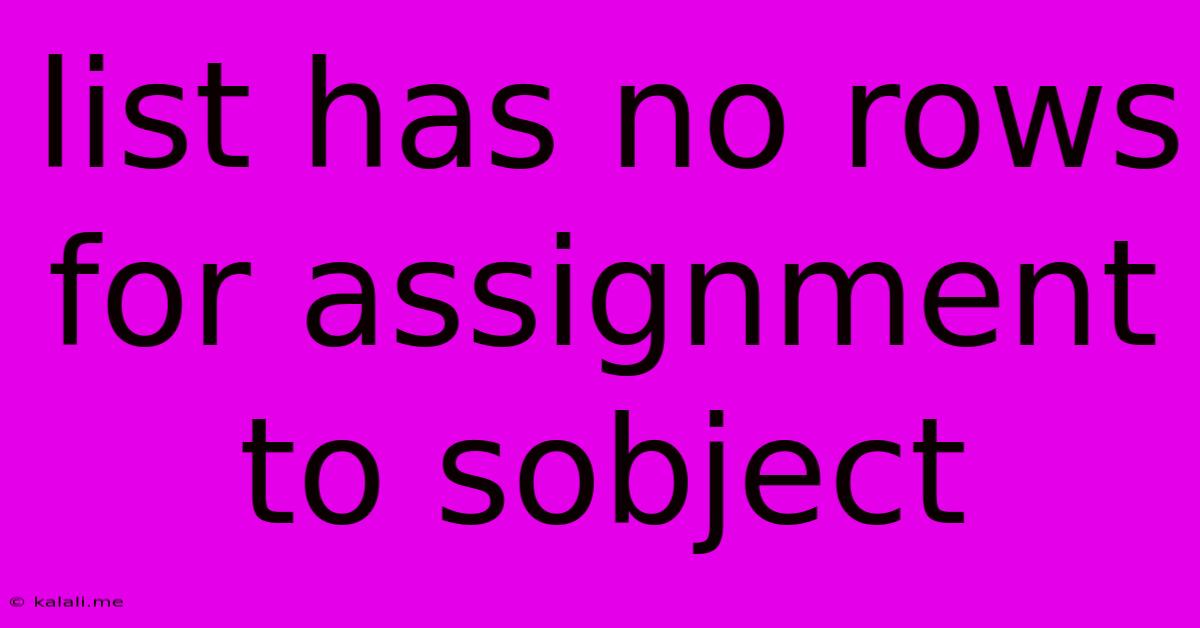List Has No Rows For Assignment To Sobject
Kalali
May 24, 2025 · 4 min read

Table of Contents
List Has No Rows for Assignment to SObject: Troubleshooting and Solutions
The error message "List has no rows for assignment to SObject" is a common headache for Salesforce developers. This typically occurs when you're trying to assign the results of a SOQL query (or a similar operation that returns a list) to a single SObject variable, but the query returns no records. This article will break down the causes of this error, offer practical solutions, and provide best practices to prevent it in the future.
What Causes This Error?
The root cause is straightforward: you're expecting a single record from your query, but the query returns an empty list. This mismatch between expectation and result triggers the error. This usually happens in scenarios where:
- Incorrect SOQL Query: The WHERE clause of your SOQL query is too restrictive, filtering out all potential records. Typos, incorrect field names, or flawed logic can all lead to an empty result set.
- Data Issues: The data in your Salesforce org may not contain records matching your query criteria. This could be due to data entry errors, incomplete data, or simply the absence of expected records.
- Incorrect Variable Type: You might be attempting to assign a list of SObjects to a variable expecting a single SObject. Salesforce expects a one-to-one mapping when assigning a list to a single SObject.
- Conditional Logic Errors: If you're using a conditional statement (like an
ifstatement) to check for the existence of records before assigning them, an error in that logic might lead to the assignment attempt with an empty list.
Solutions and Troubleshooting Steps
-
Verify Your SOQL Query:
- Double-check the WHERE clause: Carefully examine your WHERE clause for typos, incorrect field names (case-sensitive!), and logical errors. Use the Salesforce Developer Console to test your SOQL query directly and see the results.
- Check data types: Ensure that the data types in your WHERE clause match the data types of your fields.
- Consider using
LIMIT 1: If you only need one record, explicitly limit your query to one record usingLIMIT 1. This improves performance and helps prevent the error.
-
Handle Empty Result Sets Gracefully:
- Check the list size: Before assigning the list to your SObject, check its size using
list.size(). If the size is zero, handle this case appropriately, possibly by displaying a message to the user or skipping the assignment. This is the most robust solution.
Listaccounts = [SELECT Id FROM Account WHERE Name = 'Example Account']; if(accounts.size() > 0){ Account accountRecord = accounts[0]; //Process accountRecord } else { System.debug('No accounts found.'); //Handle the case where no accounts were found. } - Use
get()with error handling: Instead of directly assigning, useaccounts.get(0)and wrap it in atry-catchblock. This catches theListIndexOutOfBoundExceptionthat occurs if the list is empty.
Listaccounts = [SELECT Id FROM Account WHERE Name = 'Example Account']; Account accountRecord; try { accountRecord = accounts.get(0); //Process accountRecord } catch (ListIndexOutOfBoundException e) { System.debug('No accounts found: ' + e.getMessage()); //Handle the exception } - Check the list size: Before assigning the list to your SObject, check its size using
-
Review Your Variable Declarations:
- Correct data type: Make sure you're not trying to assign a list to a single SObject variable. The variable should be of the correct SObject type.
-
Debug Your Code:
- Use System.debug(): Strategically place
System.debug()statements throughout your code to monitor the values of your variables and the results of your SOQL queries. This will help pinpoint the exact location of the problem. - Developer Console: Utilize the Salesforce Developer Console's debug logs to trace the execution of your code and examine the values of variables at each step.
- Use System.debug(): Strategically place
Best Practices to Avoid the Error:
- Always check list sizes: Develop a habit of checking the size of lists before accessing elements, especially when dealing with SOQL query results.
- Use appropriate error handling: Employ try-catch blocks to gracefully handle exceptions like
ListIndexOutOfBoundException. - Write robust SOQL queries: Invest time in crafting accurate and efficient SOQL queries to minimize the chances of returning empty result sets.
- Test thoroughly: Comprehensive testing is crucial to identify and resolve potential issues before deploying your code to production.
By carefully following these steps and adopting these best practices, you can effectively troubleshoot and prevent the "List has no rows for assignment to SObject" error in your Salesforce development. Remember, proactive error handling and well-structured code are key to building robust and reliable Salesforce applications.
Latest Posts
Latest Posts
-
How Do You Beat Stage 9 On Bloxorz
Jul 06, 2025
-
What Is 1 2 Equivalent To In Fractions
Jul 06, 2025
-
How Do You Say Pork In Spanish
Jul 06, 2025
Related Post
Thank you for visiting our website which covers about List Has No Rows For Assignment To Sobject . We hope the information provided has been useful to you. Feel free to contact us if you have any questions or need further assistance. See you next time and don't miss to bookmark.